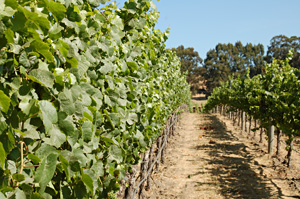
California’s prime wine producing areas could shrink dramatically over the next three decades of climate change. That’s according to a study released this week by scientists at Stanford University.
Author Noah Diffenbaugh and colleagues looked at how Napa and Santa Barbara counties could be affected by a one-degree Celsius (1.8 degrees Fahrenheit) rise in average global temperature. They found that the land suitable for growing premium wine grapes could be reduced 30-50% by 2040.
“We were asking the question about near-term decades when we expect much more moderate warming. I frankly was surprised that we found as substantial impacts on suitable area as we did,” says Diffenbaugh, a fellow at Stanford’s Woods Institute for the Environment.
The study focused on the particular climate niche needed by the top quarter of most expensive wines. In the Napa Valley, the study concludes that the average temperature during the growing season could increase as much as two degrees Fahrenheit. Growers could see as many as 10 additional extreme heat days.
“We know that the best wine grapes are grown in a relatively small area and most of that area is in California,” said Diffenbaugh. “Because that area is so small, we can infer that changes in temperature will potentially impact the ability to grow the best wine grapes.”
Diffenbaugh says these are average changes for the areas in question, “but there’s a broad range of micro-climates, even on one piece of land.”
The study was done using a global climate model, but researchers overlaid a higher-resolution grid over the United States to get the granularity they needed to study specific areas. They verified the model with past weather records collected between 1960 and 2010.
While prime land may shrink in California, the study also found that Oregon and Washington could benefit, as cooler areas there become more suitable for premium grapes.
The projections could have a dramatic impact on California’s multi-billion dollar wine industry. Diffenbaugh says it will be up to growers to adapt. “Wine growers are accustomed to dealing with the stresses of the environment and changes. And they’re used to thinking on these decadal time scales,” he said. “It’ll be interesting to see how different individuals respond to these changes as they play out,”
One thought on “The Heat is On for Napa Valley Wines”
Comments are closed.

Diffenbaugh has been totally beclowned here:
http://tiny.cc/yrhc6
All of these endless climate scares are nothing but head fakes. The fact is that there is zero evidence showing any global harm from CO2. Therefore, CO2 is harmless. QED
The “carbon” scare is based on government grant money. If corrupt scientists ever found Jesus and told the truth – that CO2 is harmless – then the grant money would dry up.
So they alarm the public. It’s their version of job security. The really crazy folks are those who still believe that a tiny, harmless trace gas comprising only 0.00039 of the atmosphere is going to cause climate catastrophe. As if.